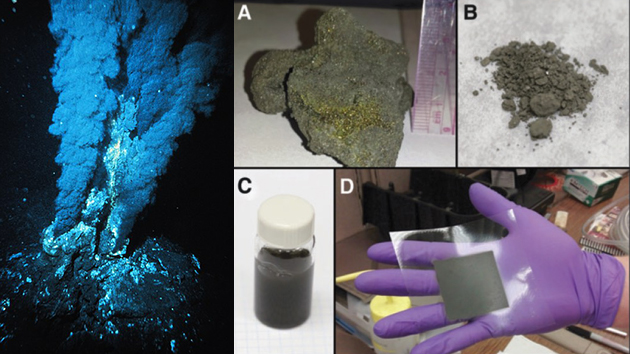-
Geoelectrodes and Fuel Cells for Simulating Hydrothermal Vent Environments
October 22, 2018 / Posted by: Miki Huynh
Left: Example of a black smoker hydrothermal vent in the Atlantic Ocean (Source: Wikimedia Commons). Right A-D: Photos showing how hydrothermal mineral samples are turned into electrode ink that can be painted onto a fuel cell electrode assembly.Seafloor hydrothermal vents are natural geo-electro-chemical systems that behave in some ways like fuel cells. They produce redox gradients that can help to support life with geochemical energy. Such vents are also thought to exist on other worlds such as Europa or Enceladus, and may provide habitable environments where life could emerge even in the absence of sunlight.
A research team led by Dr. Laurie Barge a member of the NASA Astrobiology Institute (NAI)’s Jet Propulsion Laboratory Icy World team, in collaboration with the SETI Institute node of the NAI, has used fuel cell experimental techniques to simulate the redox chemistry of a type of hydrothermal vent known as a black smoker—a deep sea vent that ejects a black-colored composition of minerals. The techniques they developed will inform scientists on methods to simulate other types of vents and evaluate if the energy produced might be able to support life.
The paper, “Geoelectrodes and Fuel Cells for Simulating Hydrothermal Vent Environments,” is published in Astrobiology.
Source: [Astrobiology (via SETI and JPL)]
- The NASA Astrobiology Institute Concludes Its 20-year Tenure
- Global Geomorphologic Map of Titan
- Molecular Cousins Discovered on Titan
- Interdisciplinary Consortia for Astrobiology Research (ICAR)
- The NASA Astrobiology Science Forum Talks Now on YouTube
- The NASA Astrobiology Science Forum: The Origin, Evolution, Distribution and Future of Astrobiology
- Alternative Earths
- Drilling for Rock-Powered Life
- Imagining a Living Universe
- Workshops Without Walls: Astrovirology